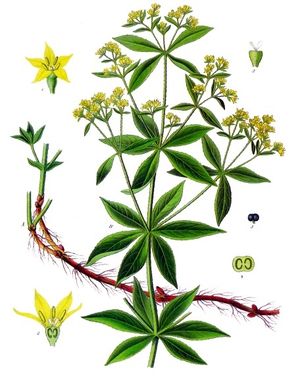Rubia tinctorum
| Rubia tinctorum | |
|---|---|

| |
| Rubia tinctorum or dyer's madder | |
| Scientific classification | |
| Kingdom: | Plantae |
| Order: | Gentianales |
| Family: | Rubiaceae |
| Tribe: | Rubieae |
| Genus: | Rubia |
| Species: | R. tinctorum |
| Binomial name | |
| ubia tinctorum | |
Also known as common madder or dyer's madder. The rhizome of this plant has traditionally been used to obtain the red pigment alizarin. [1] Alazarin gives its red color to a textile dye known as Rose madder. It was also used as a colorant, especially for paint, that is referred to as Madder lake.
The plant becomes 60-90 cm high and has small yellow flowers. The rhizomes can grow 50-100 cm into the ground.
Scientific classification
Order: Gentianales
Family: Rubiaceae
Tribe: Rubieae
Genus: Rubia
Species: R. tinctorum
Uses
The herb is used as fodder for animals.[2]
Pigment
Madder has been cultivated as an agricultural product especially for the red dye alizarin, which was used for coloring textiles and leather. This dye is also known as Rose madder. Madder lake was also used as a pigment for oil paint colors or glue. The dye was extracted from the rhizome of the madder plant. The roots of the 3-year old plants were harvested from September to November. These roots were dried, pulverized and then used as paint powder for cotton dyeing and printing. The disovery of synthesized alizarin in 1868 ended most of the madder cultivation.[3]
Medicinal uses
Madder has been used for the treatment of gall - and kidney stones, menstrual and urinary disorders, jaundice, ulcers, anemia and other diseases. But because madder is said to have carcinogenic and toxic properties, its use is prohibited in Europe.[4]
Although not as a general rule employed medicinally, Madder has been reputed as effectual in amenorrhoea, dropsy and jaundice. When taken into the stomach it imparts a red colour to the milk and urine, and to the bones of animals without sensibly affecting any other tissue. The effect is observed most quickly in the bones of young animals and in those nearest to the heart.[5]
Gallery
See also
References
External links
- Madder A Modern Herbal by Mrs. M. Grieve
- Rubia tinctorum Wikipedia


